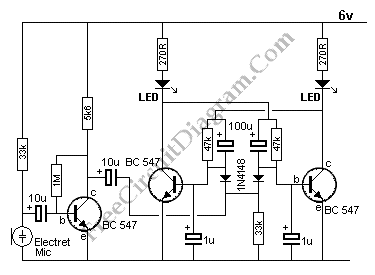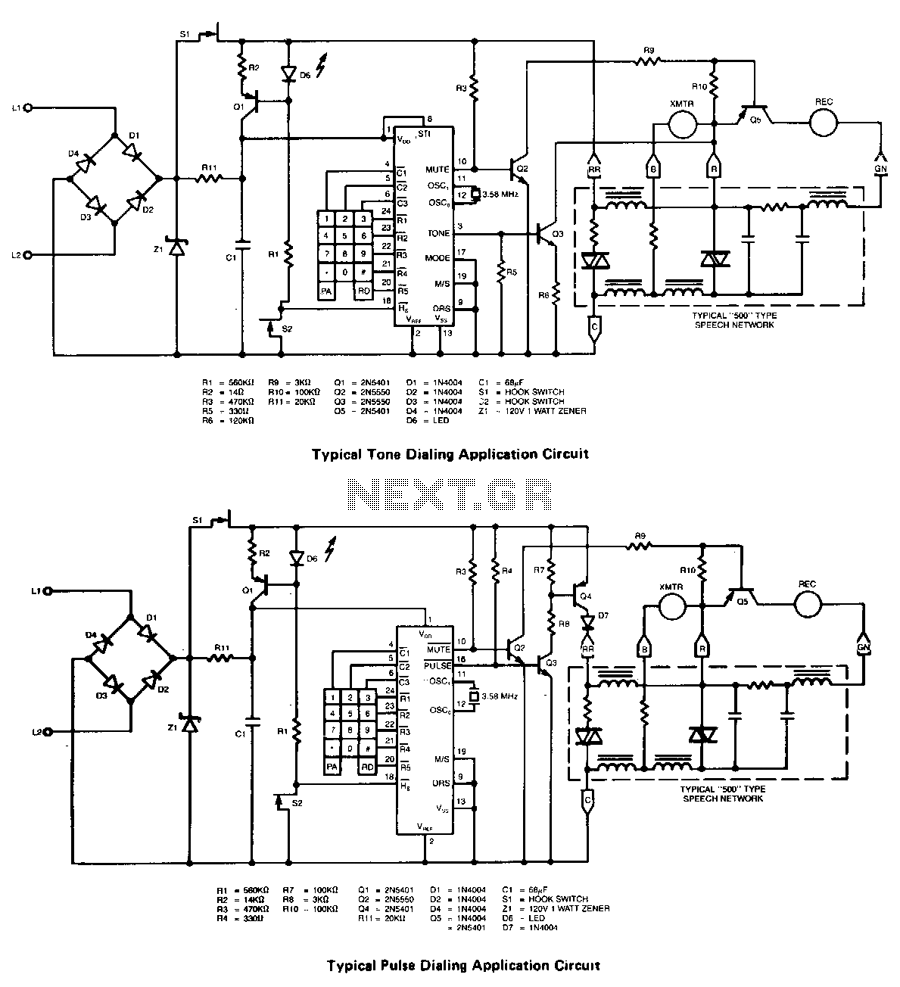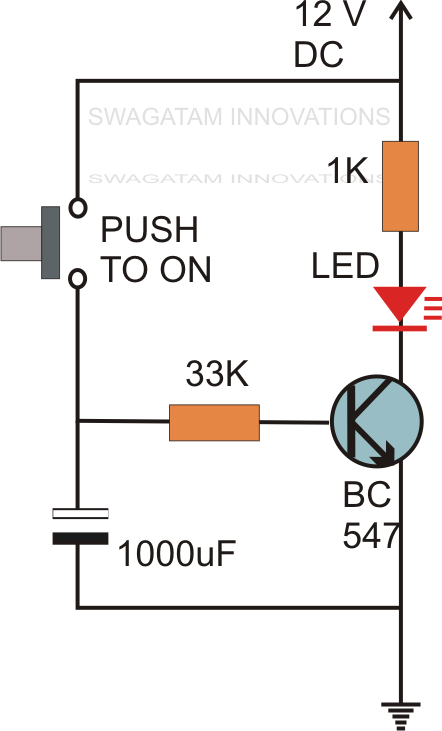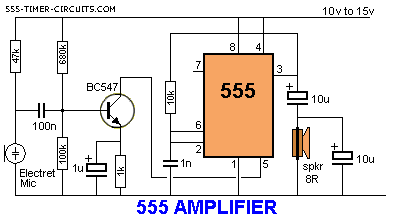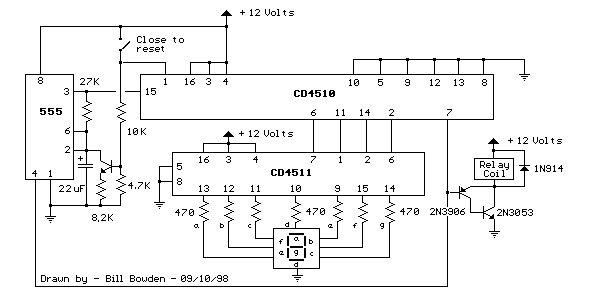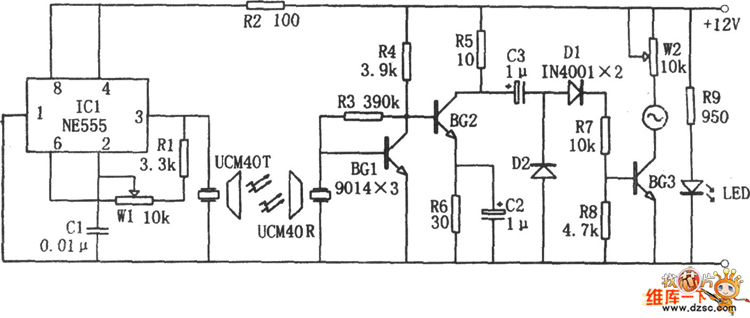
Single Channel Universal Infared Switch by 555 Timer
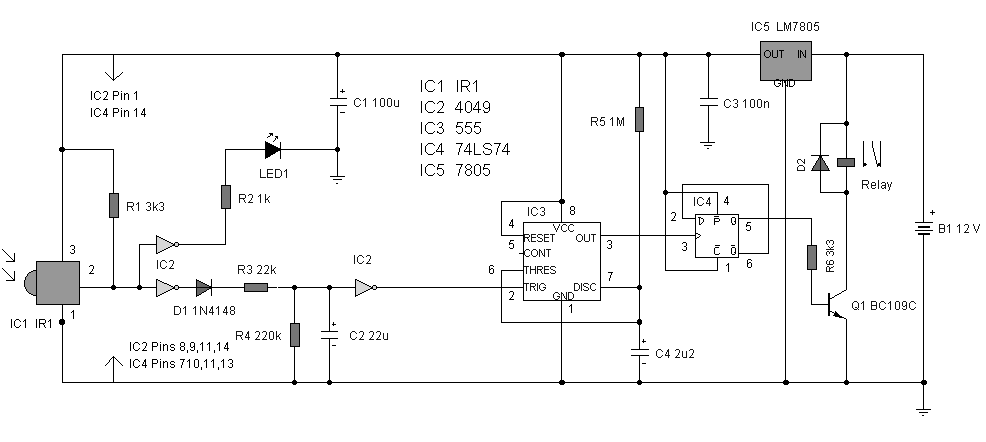
The circuit is designed to create a universal infrared switch with a single channel and ON/OFF functionality, operating in the frequency range of 36 kHz to 38 kHz, suitable for remote control applications. Infrared is a segment of the electromagnetic spectrum located between microwave/radio waves and visible light, encompassing a frequency range from 300 GHz to 400 THz and wavelengths from 1 mm to 750 nm. The circuit utilizes TSOP1738 miniaturized receivers for standard infrared remote control systems, which feature an infrared filter constructed with an epoxy package, a preamplifier, and a PIN diode mounted on a lead frame. The demodulated output signal is decoded directly by a microprocessor CMOS inverter circuit, which includes complementary MOS transistors that operate with either low or high input voltage, resulting in corresponding high or low output voltage. The receiver section employs infrared technology, which can be substituted with the TSOP1738 to convert the received modulated infrared signal into an electrical signal. Key features include compatibility with CMOS and TTL, enhanced shielding against electrical field interference, high sensitivity, significant immunity to ambient light, an integrated oscillator, a 5V output, and the capability to amplify and receive infrared signals without external components, all while housing the preamplifier circuit and photodetector together. To activate the universal switch, the button must be pressed for approximately 1.5 seconds, as determined by resistor R3 and capacitor C2. The circuit remains in this state until a reset occurs, which is initiated by pressing any button on the remote control for a brief period. Any type of button can be utilized from any remote control. Additional electronic components, such as lamps, may be connected to the relay, provided the relay contacts can handle the rated current and voltage. IC1 serves as the infrared module responsible for buffering and receiving the IR modulated signal or pulses. The transistor-transistor logic (TTL) manages the standard output, as it consumes less power and exhibits greater resistance to electrostatic discharge compared to CMOS. Resistor R1 maintains a high output in the absence of a signal. LED1 functions as a visible indicator of the switching state, driven by one gate of a CMOS inverter, which implements logical negation of the input. The time constant circuit comprises D1, C2, R3, and R4, where another gate buffers the signal. Capacitor C2 discharges through R4 while charging through R3. Diode D1 prevents quick discharge due to the low output impedance of the CMOS buffer. If IR1 is replaced with TSOP1738, the value of resistor R4 must be increased from 220K ohms to 470K ohms. The RC time constant, calculated as the product of resistance and capacitance, indicates the charging time of the capacitor. A capacitor will charge to approximately 63% of the supply voltage in one RC time constant, while 99% charging requires five RC time constants. The logic threshold of the CMOS inverter serves as the reference point for the capacitor's charging, with an input threshold of around 3.6V when the power supply is 5 Volts. This corresponds to three RC time constants, which equates to a duration of 1.5 seconds. The CMOS inverter triggers the 555 timer upon reaching this threshold, functioning as a memory circuit or flip-flop, maintaining two states: high output and low output. A simulation figure illustrates the output pulse, filtering, and received pulses, displaying a SPICE simulation of the 555 timer in monostable mode, indicating high pulse durations. The figure also depicts the jagged edges of the buffered pulses generated by the IR modulated data. The 555 timer, operating in monostable mode in IC3, removes these jagged edges. The output pulse duration is determined by resistors R5 and capacitor C4. A clean output is necessary to activate the bistable IC4.
The universal infrared switch circuit is structured around several key components that work together to ensure reliable operation. The TSOP1738 receiver module serves as the heart of the infrared detection system, converting incoming infrared signals into electrical signals that can be processed by the circuit. This module is designed for optimal sensitivity and immunity to interference, making it suitable for various environments where ambient light may fluctuate.
The circuit utilizes a CMOS inverter, which is pivotal for signal processing in this application. CMOS technology offers low power consumption and enhanced noise immunity, making it ideal for battery-operated remote control applications. The inverter's output state, controlled by the received infrared signal, is crucial for the operation of the relay that powers connected devices.
The timing elements of the circuit, specifically the resistor-capacitor (RC) combination, play a critical role in determining the response time of the switch. The time constant, defined by the product of R3 and C2, dictates how long the circuit remains in the ON state after the button is pressed. This design ensures that the switch does not inadvertently activate due to brief signal fluctuations, providing a stable control mechanism.
The inclusion of a 555 timer in monostable mode adds a layer of functionality, allowing the circuit to maintain its output state for a predetermined duration, defined by R5 and C4. This feature is particularly beneficial for applications requiring a precise timing control for device activation.
Overall, the universal infrared switch circuit exemplifies a well-thought-out design that integrates various electronic components to achieve reliable remote control functionality. Its adaptability to different remote control systems and the ability to interface with various electronic loads make it a versatile solution for infrared switching applications.The circuit was designed to produce a universal infrared switch with a single channel and ON/OFF feature to operate in 36 kHz to 38 kHz in the form of a remote control. Infrared a portion of the electromagnetic spectrum found between the microwave/radio waves and visible light region; contains a frequency range from 300 GHz to 400 THz and wave
length from 1 mm to 750 nm TSOP1738 miniaturized receivers for standard IR remote control systems having the IR filter designed with epoxy package, the preamplifier and PIN diode assembled on lead frame, and the demodulated output signal directly decoded by a microprocessor CMOS inverter a circuit containing complementary MOS transistor having either low or high input voltage with either high and low output voltage respectively The receiver side of the circuit is using the infrared that can be substituted by TSOP1738 to convert the received modulated infrared signal into electrical signal. It has features such as CMOS and TTL compatibility, improved shielding against electrical field interference, high sensitivity, high level of immunity to ambient light, integrated oscillator, 5V output, amplifies and receives the infrared signal without any external component, and encloses the preamplifier circuit and photodetector in the same housing.
For the relay to operate this universal switch, the button should be pressed for about 1. 5 seconds as established by the resistor R3 and capacitor C2. Until doing a reset, the circuit will keep on at this condition. The reset happens by pressing any button for a short period in the remote handset. The buttons could be any type and be used in any remote control. Other electronic components, like a lamp, can be connected to the relay for as long as the rated current and voltage can be handled by the relay contacts. IC1 functions as the infrared module that is responsible for buffering and receiving the IR modulated signal or pulses.
The transistor-transistor logic (TTL) handles the standard output since it uses less power and is less sensitive from electrostatic discharge damage as compared to CMOS. The output is kept high by resistor R1 in the absence of signal. LED1 acts as a visible switching aid which is driven by one gate of a CMOS inverter, which consists of gates implementing logical negation of the input.
The time constant circuit consists of D1, C2, R3 and R4 where the signal is buffered by another gate. The capacitor C2 discharges through R4 while it charges through R3. Through the low output impedance of the CMOS buffer, the quick discharge is avoided by D1. If IR1 will be replaced by TSOP1738, then resistor R4`s value need to be increased from 220K ohms to 470K ohms.
The RC time constant is calculated by the product of resistance and capacitance as this denotes the charging time by a capacitor. Only 63% of the voltage supply will be charged by a capacitor at one RC circuit while 99% of capacitor charging would require 5 RC circuits.
The logic threshold of the CMOS inverter in this circuit is the reference point of charging for the capacitor. The input threshold is around 3. 6V since the power supply is 5 Volts. This is equivalent to 3 RC circuits that will last for 1. 5 seconds. CMOS inverter triggers the 555 timer upon reaching the threshold and will function as a memory circuit or flip flop where it will stay in two states of high output and low output.
As an illustration, although not the actual circuit, the figure shows a simulation of output pulse, filtering and received pulses. It only displays a spice simulation during the duration of 555 monostable with high pulses. The figure shows jiggered edges of the further buffered pulses which are produced by the IR modulated data.
The jiggered edges are removed by the 555 timer functioning in monostable mode in IC3. The output of the pulse duration is determined by R5 and C4. To activate the bistable IC4, a clean output is required 🔗 External reference
The universal infrared switch circuit is structured around several key components that work together to ensure reliable operation. The TSOP1738 receiver module serves as the heart of the infrared detection system, converting incoming infrared signals into electrical signals that can be processed by the circuit. This module is designed for optimal sensitivity and immunity to interference, making it suitable for various environments where ambient light may fluctuate.
The circuit utilizes a CMOS inverter, which is pivotal for signal processing in this application. CMOS technology offers low power consumption and enhanced noise immunity, making it ideal for battery-operated remote control applications. The inverter's output state, controlled by the received infrared signal, is crucial for the operation of the relay that powers connected devices.
The timing elements of the circuit, specifically the resistor-capacitor (RC) combination, play a critical role in determining the response time of the switch. The time constant, defined by the product of R3 and C2, dictates how long the circuit remains in the ON state after the button is pressed. This design ensures that the switch does not inadvertently activate due to brief signal fluctuations, providing a stable control mechanism.
The inclusion of a 555 timer in monostable mode adds a layer of functionality, allowing the circuit to maintain its output state for a predetermined duration, defined by R5 and C4. This feature is particularly beneficial for applications requiring a precise timing control for device activation.
Overall, the universal infrared switch circuit exemplifies a well-thought-out design that integrates various electronic components to achieve reliable remote control functionality. Its adaptability to different remote control systems and the ability to interface with various electronic loads make it a versatile solution for infrared switching applications.The circuit was designed to produce a universal infrared switch with a single channel and ON/OFF feature to operate in 36 kHz to 38 kHz in the form of a remote control. Infrared a portion of the electromagnetic spectrum found between the microwave/radio waves and visible light region; contains a frequency range from 300 GHz to 400 THz and wave
length from 1 mm to 750 nm TSOP1738 miniaturized receivers for standard IR remote control systems having the IR filter designed with epoxy package, the preamplifier and PIN diode assembled on lead frame, and the demodulated output signal directly decoded by a microprocessor CMOS inverter a circuit containing complementary MOS transistor having either low or high input voltage with either high and low output voltage respectively The receiver side of the circuit is using the infrared that can be substituted by TSOP1738 to convert the received modulated infrared signal into electrical signal. It has features such as CMOS and TTL compatibility, improved shielding against electrical field interference, high sensitivity, high level of immunity to ambient light, integrated oscillator, 5V output, amplifies and receives the infrared signal without any external component, and encloses the preamplifier circuit and photodetector in the same housing.
For the relay to operate this universal switch, the button should be pressed for about 1. 5 seconds as established by the resistor R3 and capacitor C2. Until doing a reset, the circuit will keep on at this condition. The reset happens by pressing any button for a short period in the remote handset. The buttons could be any type and be used in any remote control. Other electronic components, like a lamp, can be connected to the relay for as long as the rated current and voltage can be handled by the relay contacts. IC1 functions as the infrared module that is responsible for buffering and receiving the IR modulated signal or pulses.
The transistor-transistor logic (TTL) handles the standard output since it uses less power and is less sensitive from electrostatic discharge damage as compared to CMOS. The output is kept high by resistor R1 in the absence of signal. LED1 acts as a visible switching aid which is driven by one gate of a CMOS inverter, which consists of gates implementing logical negation of the input.
The time constant circuit consists of D1, C2, R3 and R4 where the signal is buffered by another gate. The capacitor C2 discharges through R4 while it charges through R3. Through the low output impedance of the CMOS buffer, the quick discharge is avoided by D1. If IR1 will be replaced by TSOP1738, then resistor R4`s value need to be increased from 220K ohms to 470K ohms.
The RC time constant is calculated by the product of resistance and capacitance as this denotes the charging time by a capacitor. Only 63% of the voltage supply will be charged by a capacitor at one RC circuit while 99% of capacitor charging would require 5 RC circuits.
The logic threshold of the CMOS inverter in this circuit is the reference point of charging for the capacitor. The input threshold is around 3. 6V since the power supply is 5 Volts. This is equivalent to 3 RC circuits that will last for 1. 5 seconds. CMOS inverter triggers the 555 timer upon reaching the threshold and will function as a memory circuit or flip flop where it will stay in two states of high output and low output.
As an illustration, although not the actual circuit, the figure shows a simulation of output pulse, filtering and received pulses. It only displays a spice simulation during the duration of 555 monostable with high pulses. The figure shows jiggered edges of the further buffered pulses which are produced by the IR modulated data.
The jiggered edges are removed by the 555 timer functioning in monostable mode in IC3. The output of the pulse duration is determined by R5 and C4. To activate the bistable IC4, a clean output is required 🔗 External reference
